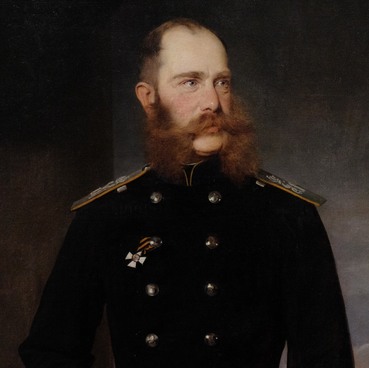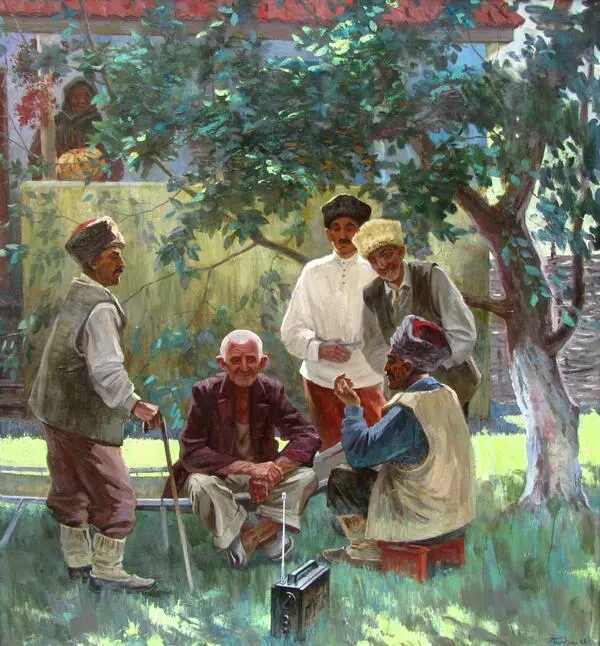Said Bitsiraev painted the Black Towers in 2002. He worked in the oil-on-cardboard technique. The artist created it under the impression of the military events that took place in the Chechen Republic in the 1990s.
The artisan depicted medieval Vainakh towers under threat of destruction. Mountaineers used to build such towers back in the Middle Ages for housing and defense. In the course of time, these structures became a symbol of Chechen history and culture. In Said Bitsiraev’s picture, the towers stand as a direct symbol of Chechnya that faced a terrible tragedy. He painted the towers in black, as if they were blackened by misfortunes.
Said Bitsiraev changes his technique depending on the subject. Sometimes, the colour comes to the fore, turning objects into a convention. When the motif of a picture is disturbing, as it is in Black Towers, the artist constructs the image with broad and expressive strokes. In his early period, the artist favoured realistic manner of painting, but later Said Bitsiraev turned to symbolism and expressionism.
Since November 1983, Said Bitsiraev has been living and working in St. Petersburg. He travels widely in Russia and abroad. The artist has visited Finland, Greece, Italy, China, Austria, and Spain. Experts particularly highlight his works on Spanish themes. The artist has painted over thirty pictures under the impression of Federico Garcia Lorca’s poetry. In 2004, art historian Abram Raskin published a book entitled ‘The Spanish Rhapsody by Said Bitsiraev’.
The artist works in different genres - thematic paintings, portraits, still-life, and landscapes. He often refers to national motifs. His works depict knife-grinders at work, conversing elders and corn pickers.
Said Bitsirayev’s works are in the collections of the Russian Museum, the A.S. Pushkin State Museum of Fine Arts, the A.A. Kadyrov Memorial Complex of Glory, the Russian Art Gallery in Beijing, as well as in private collections in Russia and abroad. In 2012, in preparation for the opening of the new building of the National Museum of the Chechen Republic, the artist donated to the museum over 80 of his works.
The artisan depicted medieval Vainakh towers under threat of destruction. Mountaineers used to build such towers back in the Middle Ages for housing and defense. In the course of time, these structures became a symbol of Chechen history and culture. In Said Bitsiraev’s picture, the towers stand as a direct symbol of Chechnya that faced a terrible tragedy. He painted the towers in black, as if they were blackened by misfortunes.
Said Bitsiraev changes his technique depending on the subject. Sometimes, the colour comes to the fore, turning objects into a convention. When the motif of a picture is disturbing, as it is in Black Towers, the artist constructs the image with broad and expressive strokes. In his early period, the artist favoured realistic manner of painting, but later Said Bitsiraev turned to symbolism and expressionism.
Since November 1983, Said Bitsiraev has been living and working in St. Petersburg. He travels widely in Russia and abroad. The artist has visited Finland, Greece, Italy, China, Austria, and Spain. Experts particularly highlight his works on Spanish themes. The artist has painted over thirty pictures under the impression of Federico Garcia Lorca’s poetry. In 2004, art historian Abram Raskin published a book entitled ‘The Spanish Rhapsody by Said Bitsiraev’.
The artist works in different genres - thematic paintings, portraits, still-life, and landscapes. He often refers to national motifs. His works depict knife-grinders at work, conversing elders and corn pickers.
Said Bitsirayev’s works are in the collections of the Russian Museum, the A.S. Pushkin State Museum of Fine Arts, the A.A. Kadyrov Memorial Complex of Glory, the Russian Art Gallery in Beijing, as well as in private collections in Russia and abroad. In 2012, in preparation for the opening of the new building of the National Museum of the Chechen Republic, the artist donated to the museum over 80 of his works.





